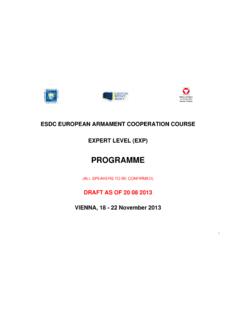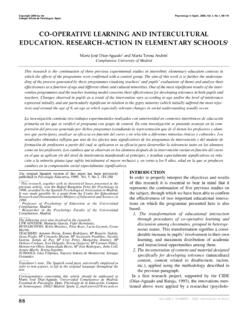Transcription of Cooperative schools UK case study - Stories
1 CASE study . A Quiet Revolution: Co- operative schools in the UK. Linda Shaw1. Table of Contents Section 1: Co- operative schools in the UK .. 2. Context and history .. 2. A new governance model 5. What makes a co- operative school ? institutional, governance and ethical perspectives .. 7. External relations .. 10. Economic data .. 12. Section 2: Analysis of the case .. 14. Impact analysis .. 14. Lessons learned and replicability .. 15. 17. Image from Co- operative schools where values make a difference': 1. Dr Linda Shaw is Vice Principal at the Co- operative College in Manchester responsible for research and international programmes. See more at: shaw/#.VE47 AmdOUdU. 1. Section 1: Co- operative schools in the UK. This case study discusses the growth of a new co- operative sector in England during the past ten years which has been one of the movement's success Stories . The development of more than 700 schools as multi stakeholder co-operatives has been aptly described as a quiet revolution'.
2 Moreover, this revolution' has occurred during the past decade against what might at first sight seem very unpromising circumstances given a rapidly changing educational environment with frequent major policy shifts and unremitting media attention. schools have been under constant pressure to continually improve performance and examination results. Students at Passmores Academy a co- operative school This case study examines the emergence of co- operative schools in England, explores how they function and assesses their wider impact. Context and history Education and schooling systems are shaped by national histories, cultures and identities. So, whilst this paper tackles current developments in education in the UK, taking a long view' will help us to unpack some of the key drivers for these changes to fully understand the nature of the new sector and the different models that have developed. In the UK as a whole, the 1944 Education Act laid down the arrangements for the policy setting, for the funding and for the delivery of state funded school education for over fifty years.
3 The Act divided responsibility for education between central government, which was to set national policies and allocate resources; the local education authorities (LEAs), which were to set local policies and allocate resources to schools ; and the schools themselves, whose head teachers and governing bodies would set school policies and manage the resources. These arrangements meant that in practice local municipalities, who appointed the LEAs, played a central role in the operation, ownership and management of local state schools . There were other actors in the English education system which evolved in partnership with the mainstream Christian churches, whose involvement in the provision of education pre-dated that of the state. The result was, under the 1944 Act, that the churches maintained a key role in the state sector and their ability to establish schools in response to demand from parents. Today, around a third of government maintained schools have a religious character and are popularly known as faith schools .
4 Faith 2. schools are mostly run like other state schools . They have to follow the national curriculum except for religious studies, where they are free to only teach about their own religion. The admissions criteria and staffing policies may be different too, although anyone can apply for a place. Around two thirds of faith schools are connected to the Anglican Church. Despite the importance of education for nineteenth century co-operators such as Robert Owen and the Rochdale Pioneers, by the twentieth century a considerable distance has evolved between the co- operative movement and schools . By the early 20th century, the practice was that co-operatives provided education primarily for adult co-operators. The movement had willingly conceded a pre- eminent role to the government in the provision of primary and secondary. As a Fabian society pamphlet put it in 1923: No-one, whether a co-operator or not, would urge any other course. The State and not the Movement, should supply a general education, and co- operative education, if it is to exist must take as its subjects those which do not fall within the curriculum of general education and which have some definite connection with the objects or principles of co-operation.
5 (Dawson, 1923:10). This division of educational responsibilities was to continue largely unchallenged for the rest of the century so that despite the importance of education to the movement, education about co- operatives remained largely absent from the school curriculum and the movement played no role at all in the governance of schools . There were some individual initiatives by certain co- operative societies to do some work in schools on co-operatives and co-operation but these initiatives remained very fragmented and often short lived. A changing environment The 1944 Act did not establish a single national curriculum and national examinations were the responsibility of a number of different awarding bodies often linked to universities. schools chose a curriculum in part to meet the requirements of the awarding bodies. It was not until the 1980s, under the Thatcher government, that major changes started to happen. Firstly, in 1987, a national qualifications framework for workplace based learning was established (although the framework did not include schools , Higher Education or Professional Status qualifications).
6 Then the following year,1988, saw the introduction of a national curriculum for schools together with standardised national testing on attainment measured against the curriculum. A further key change was a growing emphasis on more local management of schools giving greater budgetary power to individual schools and shifting power away from the local education authorities. Four years later, in 1992, league tables were introduced which measured the annual performance of schools in national tests and examinations against each. The stated aim was to give parents more information and choice about schools but in reality they have also been synonymous with greater central direction over schools as different governments have used them to drive change and set attainment targets for schools . Although criticised for their narrow focus, they have since remained an essential part of the education landscape. 3. A second major round of schools ' reform in England started under the Labour government in the 1990s which culminated in the 2002 Education Act.
7 This allowed schools much more freedom to manage their own affairs with schools now able to control 85% of their budget and a further lessening for the role of local authorities. The Act also opened the doors for more involvement of the private sector in state provision and enabled a greater diversity in the provision of secondary education by allowing the development of new types of specialist schools for 11 - 18 year olds. During the same time, there was a rekindling of interest within the co- operative movement about working in schools and a number of new initiatives began to be developed. Firstly, in 2002, the Co- operative Group supported the setting up of the Young Co-operatives'. This was a programme to help school students to start and manage their own co-operatives, which sourced and sold Fairtrade products. The programme proved very popular with hundreds of such co-operatives set up. It is still running today and the range of activities undertaken by the co-operatives has expanded to include recycling and horticulture.
8 Secondly, a series of educational and curriculum resources on co- operatives and Fair trade were developed by the UKCC to introduce the concept of Fairtrade and co- operatives to their students in both primary and secondary schools . An example of these resources is the Young Co-operatives Action Kit2, which was recently updated in 2013. It covers a range of topics including how to decide what activities to undertake, holding meetings, budgeting, making the rules and selling its products, and right up to evaluating the project. There is a teacher's guide and separate activity packs for younger and older age groups. Just as importantly, it introduces what co-operatives are, where they came from and what makes them different to other types of businesses, as well as providing case studies from other Young Co- operatives as inspiration. Later in the decade, the College also worked in partnership with one of the UK examination agencies, ASDAN, to produce a range of accredited programmes and curriculum materials to support the introduction of co- operative studies into the curriculum.
9 These programmes provide a framework of qualifications, based on this co- operative curriculum, for students from primary through to secondary level. Thirdly, and in response to the 2002 Education Act, which allowed organisations such as businesses and charities to develop new partnership relationships with schools , the Co- operative Group and Co- operative College also began to explore related possibilities for co- operative development. In 2003, the UKCC worked with an educational charity, CfBT Education Trust, to research options for co- operative and mutual models in the English education system. The findings were made available in the 2007 college publication Education and Learning', which drew on a number of international examples and also contained a chapter on running schools as co-operatives. (Wilson and Mills, 2007). In 2004, the Co- operative Group sponsored eight (later ten) secondary schools , called Business and Enterprise Colleges, specialising in co- operative business and enterprise and which were supported by the earlier curriculum resources commissioned from the college.
10 Curriculum working groups were established across the network to explore how links with the co- operative movement could 2. 4. enrich the curriculum in the three core subjects: Information Technology, Maths and Business Studies. The resulting resources, which include a pack dedicated to the father of social enterprise, Robert Owen, are freely available to download from Additional support for these Business and Enterprise Colleges from the Co- operative Group and the College has included the provision of a sponsor governor in every school , organising regional networking activities, staff training and curriculum development. A new governance model emerges In England, the education reforms continued with another Act in 2006 which devolved further powers to schools . This enabled a school to own its own assets, employ staff directly and set its own admission arrangements. To do this, schools needed to set themselves up as an autonomous body as an independent trust using a model similar to the one used by faith schools .









